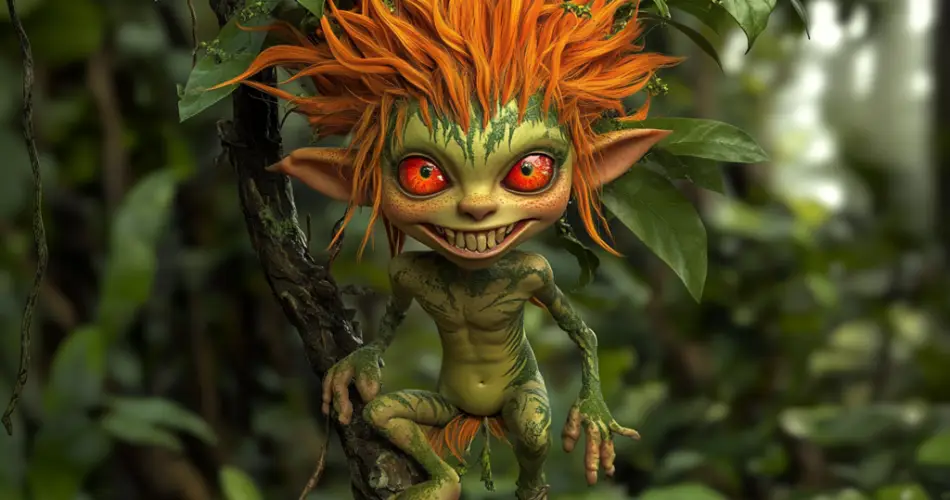On January 21, 2024, Renato Bayma Gaia broke the Guinness World Record for the largest foot rotation by a male, bending his foot 210.66 degrees backward. His reason? To pay homage to the Curupira.
The Curupira, a captivating folkloric figure, is one of the earliest documented and oldest indigenous legends in Brazilian folklore. Like Renato’s record-breaking feat, the Curupira is notable for its distinctive backward feet.
Backward feet, though seemingly a handicap, grant the Curupira an upper hand in surprising ways. That, along with its other features and rich character, which we’ll delve into in this post, has captivated millions for millenniums.
What is a Curupira?
The Curupira is a mythical figure with backwards-facing feet, often depicted as a small, human-like creature with striking red hair or even flames as hair, and vibrant green or black skin, typically seen riding a collared peccary. It is said to be extremely agile, emit a shrill whistling sound, and possess the ability to shapeshift. It moves through the dense jungle with incredible speed, making it hard to spot or identify and nearly impossible to catch or outwit.
The Curupira’s reversed feet are notably effective in confusing those who attempt to follow its tracks. The backwards footprints lead pursuers deeper into the forest where the creature had just left. And as they go deeper, they lose all sense of direction and become lost.
Curupiras often avoid densely populated areas, living deep within the forest. However, they love consuming tobacco and pinga, Brazil’s most popular distilled alcoholic spirit.
The Curupira originates from the indigenous cultures of Brazil, where it has long been both revered and feared. But, the earliest recorded mention of the Curupira name is by José de Anchieta on 30 May 1560.
Curupira’s connection to Brazil is clear: Forests in Brazil are often plagued by wildfires, reminiscent of Curupira’s flaming hair, and people sometimes get lost when they wander too far into the forests, paralleling its confusing backwards-facing feet. The Curupira embodies the value Brazilians place on their forest resources – and, of course, pinga.
What Does a Curupira Do?

The Curupira protects the forest’s plants and animals. Ancient tales recount the Curupira attacking those who seek to exploit the forest for personal gain. Hence, it is often the bane of greedy hunters, loggers, and anyone who ventures into the forest to take more than is necessary.
While Curupira’s unsettling appearance and high-pitched voice often scare off intruders, some accounts make mention of them whipping, hurting, and even killing victims. However, offerings like bird feathers, fans, arrows, and other items can appease or distract the Brazilian monster.
The Curupira is also said to be skilled at creating illusions, making travellers see and hear things that are not there, causing them to stumble, become disoriented, and get lost. In some stories, the illusions and eerie, high-pitched whistling cries send shivers down the spine and drive victims to madness.
While the Curupira is formidable, it’s not the only forest protector in Brazilian folklore. Other creatures like the Caipora similarly confuse or scare away hunters, and hide animal tracks. The Curupira’s role as a force of moderation is also reflected in other myths like the Kikimora, or the Cuca legends.
Is the Curupira Good or Bad?

Despite its unassuming short stature, the Curupira has often been labelled “Demon”, “Dangerous”, “Malevolent”, and “Scary”, because of its looks, abilities, and behaviours. While opinions of its goodness or badness can vary, one thing is clear: It vigilantly protects the forest and has a burning vengeance that knows no bounds.
However, from a utilitarian standpoint, Curupira’s drastic measures could be for the greater good. For instance, the Curupira is said to severely punish poachers – especially those who hunt for pleasure or who kill breeding females or defenceless juveniles.
The Curupira myth might have been developed to fight deforestation and protect forest species from extinction. As a guardian and avenger, it is not out of place to say it is both good and bad – a moral duality that exists in many natural and supernatural beings.
The Curupira in Modern Culture
The Curupira still influence modern culture. Media often depicts it as a mysterious and powerful figure protecting the forest from those who seek to destroy it.
For instance, in the 1999-2002 series “BeastMaster,” the Curupira appeared as a Demon, having the form of a young, blonde girl dressed in green that protected animals, particularly tigers, and could drain human life with a kiss.
In the 2020 animated film “The Red Scroll,”, one scene clearly shows a character’s footprints appearing inverted on the ground. Interestingly, this character, Idril was voiced by the Brazilian musician, Any Gabrielly.
In the 2021 Netflix Brazilian series “Invisible City“, the Curupira was depicted as having backward feet, a flaming head, with the signature whistles.
Even One Piece fans theorise that the Curupira heavily influenced Luffy’s Gear 5 powers, which he obtained from eating a Devil Fruit named after Nika, the Sun God. The Sun God, as depicted in the anime, shares several characteristics with the Curupira, and is generally portrayed as a “Liberator”. The creator of One Piece even stated Luffy would be native to Brazil, just like the Curupira.
Conclusion: Fear The Red Haired Man With Backwards Feet
The stories of the Curupira allude to the consequences of greed and environmental destruction.
In a world with vast and diverse ecosystems, the Curupira symbolises the belief that nature is a living entity, deserving of respect and protection.
While the tales of the Curupira may not be literal, the legends encourage us to think critically about our actions, especially in our relationship with nature as there are often unanticipated, and unsettling consequences.
